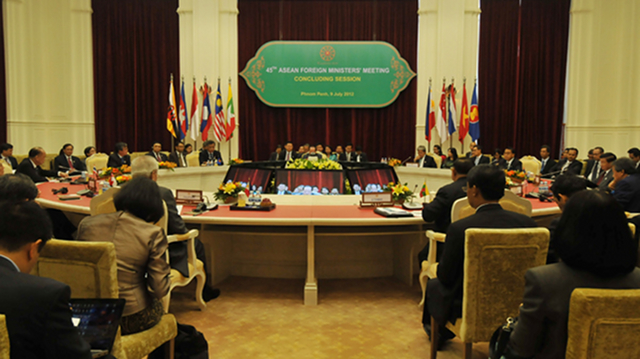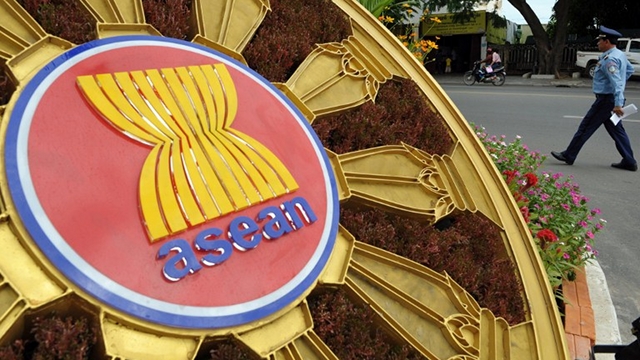MANILA, Philippines – Cambodia accuses the Philippines of engaging in “dirty politics,” while the Philippines wants Cambodia to prove its version of events during the recent Association of Southeast Asian Nations (Asean) foreign ministers' summit in Phnom Penh.
In a letter to the Philippine Star published Monday, July 30, Cambodian Ambassador to the Philippines Hos Sereythonh took exception to an article by Philippine Foreign Affairs (DFA) Undersecretary Erlinda Basilio titled, “Why There Was No Asean Joint Communiqué.”
Hos said it was “fiction” when Basilio said the Asean Ministers' Meeting (AMM) chair, Cambodia, failed to gain consensus and thus caused the absence of the traditional joint communiqué for the first time in 45 years.
The truth was, 8 out of 10 Asean member-states agreed to the 132 points in the proposed AMM joint communiqué, Hos claimed. He said the points agreed upon included 3 paragraphs related to the South China Sea.
 CONTROVERSIAL
SUMMIT. The Philippines and Cambodia trade barbs over the recent Asean
Ministers' Meeting. Photo courtesy of Agence Kampuchea Presse
CONTROVERSIAL
SUMMIT. The Philippines and Cambodia trade barbs over the recent Asean
Ministers' Meeting. Photo courtesy of Agence Kampuchea PresseThe only paragraph that did not get the majority's nod, Hos said, was the one on bilateral disputes between the Philippines and China, and Vietnam and China. This, “despite the tireless efforts of the Asean chair as well as those of other Asean member-states.”
He added that since the summit began July 9 until it ended July 13, the Philippines and Vietnam insisted on including their “national bilateral” disputes with China in the joint communiqué.
“By doing so, the two countries wanted to sabotage and hijack the (joint communiqué) as well as the AMM, and to make them fail before the eyes of the Asean dialogue partners and the international community. It was truly an un-Asean spirit of unity and solidarity,” Hos said.
'Sour' mood
He added that even before the AMM, Cambodia already wrote all Asean foreign ministers to secure the member-states' consensus on a possible statement on the South China Sea disputes. This was in response to “pressures” received by Cambodia since April to issue a statement on this.
He noted that Cambodia waited for several weeks but saw no consensus on the issue, particularly the Philippine-China dispute over Scarborough Shoal. “Therefore, no one could blame Cambodia for not issuing the Asean statement, because to have done so Cambodia would had violated the Asean Charter on the consensus-based decision-making.”
The Cambodian ambassador thus blamed the Philippines and Vietnam for the “souring of the mood” during the AMM, which “could undoubtedly be attributed to the inflexible and nonnegotiable position of the two countries.”
 NO CONSENSUS. The Asean Foreign Ministers' Meeting ends without the traditional joint statement. AFP Photo/Tang Chhin Sothy
NO CONSENSUS. The Asean Foreign Ministers' Meeting ends without the traditional joint statement. AFP Photo/Tang Chhin SothyIn her statement, the Philippines' Basilio said “the 'souring of the mood' was attributed by everyone who was there to the failure of Asean to issue a joint communiqué, resulting from the chair's firm position not to reflect the recent developments in the South China Sea despite the view of the majority of the member states that these developments impinge on the overall security of the region.”
Hos said, “(To) try to blame Cambodia, as the Asean chair, for what essentially was the inflexible and non-negotiable positions of the two countries of Asean, is dirty politics and therefore it should have no place in Asean.”
Explain, says DFA
In a statement Tuesday, July 31, however, the Philippines' foreign affairs department belied the Cambodian ambassador's claims. “We want him to explain what he meant when he stated that the 'inflexible and non-negotiable position of two countries of ASEAN is dirty politics,'” DFA spokesperson Raul Hernandez said.
Hernandez explained that Cambodia had appointed a committ
ee, which included the Philippines and Vietnam, “which had full authority if it could reach a consensus on a final draft.” He said at least 5 final drafts achieved a consensus, but Cambodia disapproved all these.
The DFA summoned Hos on Monday and Tuesday to explain, but the latter said he was not feeling well. “We will continue to summon him until he is able to come,” noted Hernandez.
“We will also ask where the ambassador obtained the information on the events as narrated in his letter since these are not consistent with the records of the Asean meetings,” Hernandez said. He added the DFA will ask Hos if he can authorize the release of evidence to the public, “which should end all speculation on what really happened in Phnom Penh.”
The incident in Phnom Penh has a silver lining, however, a Southeast Asia analyst told Rappler.
Other experts note the importance of a unified Asean stance. Ernest Bower, senior adviser and director of the Center for Strategic and International Studies' Southeast Asia Program, explained that a divided Asean is in China's interests.
“Filipinos should know what happened in Phnom Penh and understand that the message from Cambodia is not 'Asean is messy and we should proceed carefully and reduce our engagement and investment,' but rather 'Asean unity is not supported by China and this is an indication we need to redouble our efforts to engage and support Asean’s goals for unity,'” wrote Bower in a Thought Leaders piece for Rappler. – Rappler.com
“That could help galvanize the rest of Asean together, and treat Cambodia and the Cambodian leadership as pariahs, as they should be treated,” said Zachary Abuza, political science professor at Simmons College in Boston, on Rappler's Talk Thursday






